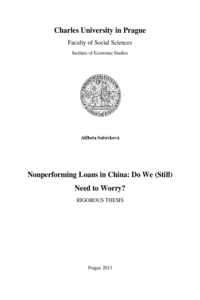Nonperforming Loans in China: Do We (Still) Need to Worry?
Nedobytné pohledávky v Číně
rigorous thesis (DEFENDED)

View/
Permanent link
http://hdl.handle.net/20.500.11956/60910Identifiers
Study Information System: 126937
CU Caralogue: 990015665500106986
Collections
- Kvalifikační práce [18508]
Author
Advisor
Referee
Lopušník, Ondřej
Faculty / Institute
Faculty of Social Sciences
Discipline
Economics
Department
Institute of Economic Studies
Date of defense
20. 3. 2013
Publisher
Univerzita Karlova, Fakulta sociálních vědLanguage
English
Grade
Pass
Keywords (Czech)
nedobytné dlhy, Čína, "out-of-sample" metóda, nátlakové skupiny, čínska centrálna bankaKeywords (English)
nonperforming loans, China, out-of-sample method, pressure groups, People's Bank of ChinaTáto práca analyzuje problematiku nedobytných pohľadávok v Číne a zaoberá sa vývojom finančného sektora od počiatku reformných snáh Deng Xiaoping-a v roku 1978. Doraz je kladený na inštitucionálne prostredie, ktoré je jedným z hlavných faktorov nedobytných pohľadávok. Použitím dát 23 krajín počas rokov 2000 až 2009 skúmame vplyv makroekonomických veličín na nedobytné dlhy. Jeden z determinantov, produkčná medzera, je odhadnutý na základe metódy roznorodých nepozorovaných komponentov (MUC) s technikou Kalman filtra. Použitím "out-of-sample" metódy aplikovanej na päť skupín krajín prichádzame k záveru, že nedobytné dlhy sú v oficiálnych čínskych štatistikách podhodnotené, najmä ku koncu študovaného obdobia, čo je možným znakom zvyšujúcej sa makroekonomickej nestability v Číne. Nakoniec použitím Havrilesky metódy odvodíme nezávislosť čínskej centrálnej banky pri zverejňovaní štatistík nedobytných pohľadávok.
This thesis discusses the issue of nonperforming loans in China, and the financial sector developments from the beginning of Deng Xiaoping's reform era in 1978. The focus is put on the underlying institutional framework as it is found to be one of the key contributing factors of the NPLs. Utilizing a sample of 23 countries over the period 2000-2009, we estimate the impact of macroeconomic determinants on NPLs. One of the regressors, output gap, is estimated via Kalman filtering technique based on the multivariate unobserved component (MUC) method. Consequently, out-of-sample method forecasts for five subgroups of countries, which thus provide different benchmarks for China, are compared with official data. The conclusion argues the NPLs ratio to be understated in official statistics, especially towards the end of the series, which might be a sign of increasing macroeconomic instability in China. Finally, the independence of the China's central bank to report the true NPLs ratio is inferred from a monetary policy study which utilizes the Havrilesky method.
